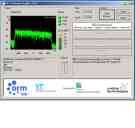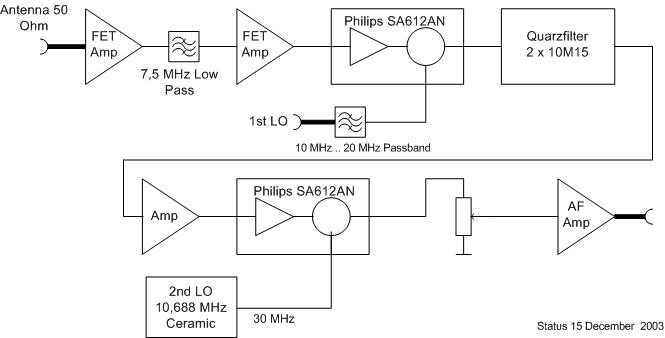© Christoph Petermann DF9CY 2005
Status: Test Phase ! The receiver is already working and
first DRM signals could be seen on the analyser. Performance is close to the
expected values.
Last Revision: 29 March 2005

TAKE CARE ! Further Down you can download already Version 02 - The text has been changed.
In many ways television and radio will change throughout the near future. Especially we will see the change from analogue to digital technologies like DAB and DVB. So far there has not been a change in the oldest technology the Amplitude Modulation (AM) which is used on the Longwave-, Mediumwave- and Shortwavebands since the beginning of radio. But now we are close to have a change and we already have had some inaugural transmissions started on 16 June 2003. The new technology is called DRM = Digital Radio Mondiale.
What are the benefits from this ? We will have a dramatic increase in sound quality to close to the FM-like standard where we still suffer from the rather poor audio with interferences, fading and noise.
I will not discuss on the technology here, because a lot of material exists already in the internet. Here are a number of links to sites of interest:
 |
The choice
I thought I should take part and do something that enables the reception of DRM signals. There were several ways to achieve this goal I considered. All systems shall provide a 12 kHz output for a signal of >10kHz bandwidth to feed into a PC soundcard.
Receiver modification of my TS690S receiver.
A small PCB containing a mixer down to 12 kHz IF available for about 50
Euro.
The receiver shall be transportable as I want to show the simplicity of such
a system AND I do not like to modify the well performing TS690S. So I did
not further think about this solution, even the receiver is destinated to as
it has a built-in 12 kHz bandwidth filter.
Modification of an existing radio.
I do not have an appropriate radio ...
Buying a receiver
That is what I did to get a "feeling" for DRM. My choice fell upon
the TenTec RX320D, a black-box which receives from less than 100 kHz to 30
MHz and can only be operated from a PC and has very good performance. I must
admit, it was not easy to spend more than 400 Euro for this little thing. If
you look inside you will not understand where the money has gone to.
Develop a demonstration receiver with minimal effort.
That is the best idea. I came to a small receiver system with components
"out-of-the-box". This is what this article is about.
Software

This is one software package for Windows (tm) based machines which is from Fraunhofer Institute. Price is about 60 Euro. See above link.
Or this one : DREAM Software Project / LINUX. This has become my favourite software now.
The Specification
I wanted to have a receiver that allows the reception of signals whereever they are transmitted in the RF spectrum to 30 MHz.
The receiver shall have the following specification:
- Frequency Range: 150 kHz to 7,5 MHz
- Bandwidth: > 10 kHz with flat top
- Concept: Double conversion; 1st IF 10,7 MHz with two 10M15 QFilters
- Input: low impedance 50 Ohm with 7,5 MHz low pass filtering.
- Option: additional FET amplifier for short antennas; switchable
- Output: 1 kOhm or less to feed into soundcard
- Components: as few possible - mostly out of my "box"
- Oscillators: 1st LO is external with RF generator; 2nd LO with use of a 10.688 MHz ceramic resonator.
- Oscillator range: 10 .. 20 MHz
The Concept of Receiver 1

The RF signal is fed via the antenna connector to the FET amplifier and then to the 7,5 MHz low pass filter. I choose the 1st IF to be 10,7 MHz as I already have an appropriate Quarzfilter for 10,7 MHz. The low pass filter has a 3 dB bandwidth of 7,5 MHz. Behind the LP filter the signal passes a FET and is led into the Philips SA612AN mixer. In any case the mixers are used unsymmetrical. The 1st LO signal is from an external signal generator. Perhaps a simple DDS signal generator will be built some time. The first IF I set now to 10,7 MHz, as I have some 10,7 MHz Hi-Q Quarzfilters with a bandwidth of 15 kHz. They have a flat passband with a ripple of less than 1 dB. Behind the filter follows a 2nd SA612AN for downmixing to 12 kHz IF with is demanded by the Software Receiver. The 12 kHz signal is fed through a LM386 AF amplifier with a gain of 20 dB fixed and a very flat response.
Changed: I have changed the concept from 30,2 MHz to 10,7 MHz, because of two reasons: 1st: I want to use a DDS generator, but this has a maximum frequency of 20 MHz. 2nd: The 2nd mixer is easier to build at 10,7 MHz with a ceramic filter used as resonator. It can be easily tuned.
The Circuit Diagram (updated)
Download the DDSR2 Redesign with complete circuit diagram. It is a PDF file.
Download the DDSR1 V02 complete circuit diagram. It is a PDF file.
Download the DRMRX V01 complete circuit diagram. It is a PDF file. For comparison only.
The Construction
I do not have a printed circuit board made for this receiver. I have good experience with experimental boards with drilled holes and one side screened by a ground plane.
The Component List
Bill of Material for rx-1-version_02.Bom (Generated by Protel)
Used Part Type Designator Footprint
==== ==================== ================ ==========
1 +12V X1
2 0.33µ L1 L3
1 0.39µ L2
1 0.47µ C28
1 1.5k R5
1 1k R15
6 1n C10 C18 C25 C30
C32 C37
1 2,2k R11
1 2.2k R7
1 2.2n C27
2 3k3 R9 R17
1 4p7 C35
1 10 R4
1 10k R3
4 10n C1 C12 C22 C24
1 10µ (Bipolar) C29
1 22k R12
1 22uH L4
1 47k R1
1 47n C21
1 47µ C8
1 56 R6
3 100 R2 R10 R16
1 100 .. 400p C16
12 100n C6 C7 C9 C11 C13
C14 C19 C23 C26
C33 C36 C38
1 100µ C20
2 150 C2 C5
2 220 R14 R18
1 220p C31
2 270 C3 C4
1 470 R13
1 680p C17
1 ANTENNA E1
2 BF245 Q1 Q2
1 CAP C34
1 DIP8-NSC-LM386 IC3
2 DIP8-PHILIPS-SA612A IC1 IC2
1 NPN1 Q3
1 Output X2
1 POT2 R8
2 QF 10M15 QF1 QF2
1 REG 7808 Regulator
1 SFE107 C15
1 SOCKET Oscillator Input
------------------------------------------------------------------
BF245 Download datasheet Philips BF245
Philips SA612AN Download datasheet Philips SA612
double sided experimental epoxy pc board